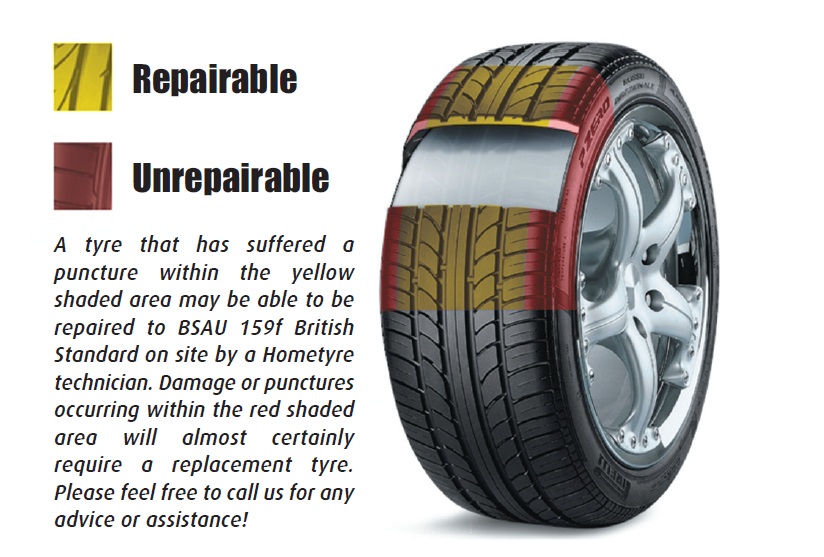From potholes to stray nails and screws, your tires can encounter a lot of hazards on the road. And when they become damaged or go flat, you might be wondering whether you should purchase a new set or get the tire repaired professionally.
Not every flat or punctured tire can be fixed, but there are other instances where you can get the tire — and your entire car — back on the road with a quick repair. Read on to learn what kind of tire damage can be repaired and when you should get a replacement.
Puncture location and severity of damage can often be the deciding factors between getting a tire repaired vs. replaced. If you've got a tire that's been punctured in the tread area and it doesn't measure more than 1/4 of an inch (6mm) in diameter, a simple repair may do the trick.
If the tire has two punctures, getting a tire repaired may still be an option as long as the punctures are at least 16 inches apart and the maximum number of repairs does not exceed a total of 2 in the tire. Any more punctures than that, and you should consider getting a new tire. Punctured tires will likely need to be replaced if:
Durable run-flats, such as Bridgestone DriveGuard tires, can often buy you a little more time in a flat tire situation. But if driven on with less than 15PSI, they may not be repairable. To prevent this issue on run flats and otherwise, avoid driving your vehicle if you have a flat or are low on air.
If you notice a bubble in your tire's sidewall, this has likely been incurred by high-impact damage. Factors like driving on a flat, hitting a pothole or curb the wrong way, riding over speed bumps or railroad crossings too quickly, or overloading your tires can all lead to this issue. Although this tiny bulge may not seem intimidating, tires with side bubbles are not repairable, and you should have the tire replaced as soon as possible.
Although this tiny bulge may not seem intimidating, tires with side bubbles are not repairable, and you should have the tire replaced as soon as possible.
Repaired tires can often be mended again if the damage doesn't compromise a previously repaired area. For example, if you have a nail-in-tire situation, you may be able to do a quick repair if the puncture location doesn't overlap with a previous tire injury and the repair was done properly. If it does overlap, you will likely need a replacement.
Oftentimes, affected tires will need to be replaced following a major incident. If the tire has sustained serious damage in a crash, such as significant cuts or tread separation, it should be replaced, not repaired.
You might be tempted to do a quick fix when you do have a flat or damaged tire. Here are two that can be used in emergency or short-term situations but shouldn't be considered long-term tire repairs:
These fast fixes are a double-edged sword.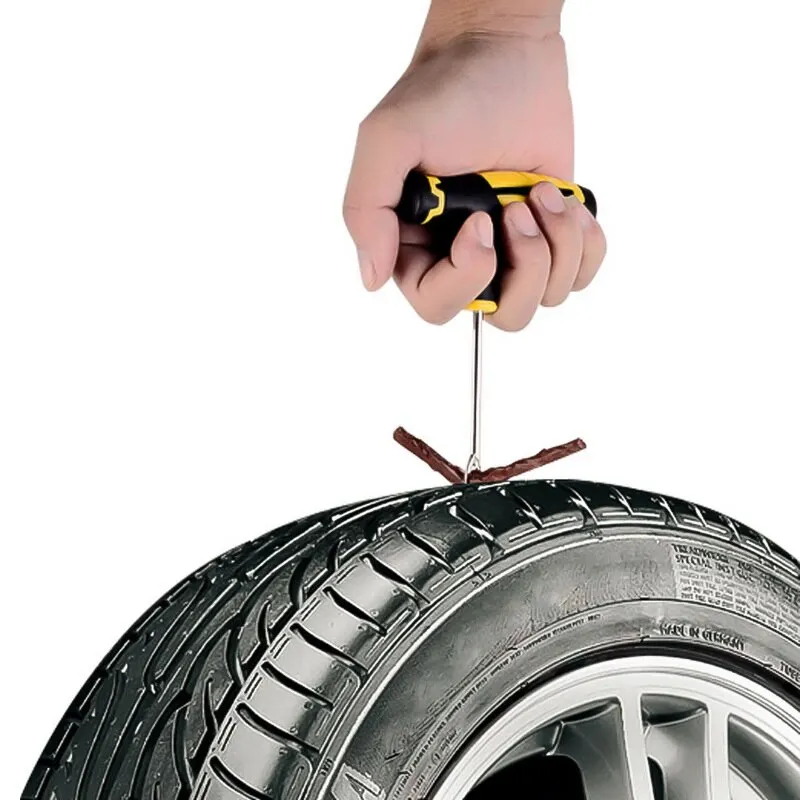 They'll help you get your car to a local Firestone Complete Auto Care, but don't count on them to keep you on the road for very long. Tire sealants can freeze in cold weather, damage your tire pressure monitoring system, and prove ineffective at repairing any tire damage that's more serious than a slow leak or small hole. It's also important to note that our technicians will not be able to fix punctures in tires with emergency temporary sealants.
They'll help you get your car to a local Firestone Complete Auto Care, but don't count on them to keep you on the road for very long. Tire sealants can freeze in cold weather, damage your tire pressure monitoring system, and prove ineffective at repairing any tire damage that's more serious than a slow leak or small hole. It's also important to note that our technicians will not be able to fix punctures in tires with emergency temporary sealants.
Again, these are quick fixes that aren't meant to enable long-term use of a punctured or damaged tire. When considering a flat tire patch or replacement, remember that a patch doesn't fill in the hole left by a puncture — while a plug doesn't offer a permanent seal. In short, patching or plugging alone are never adequate long-term solutions. That's why at Firestone, our technicians can use a patch-plug combo to provide an adequate long-term solution for some tire punctures.
To ensure your tire is safely repaired or replaced, it's best to have it inspected and serviced by a trained technician.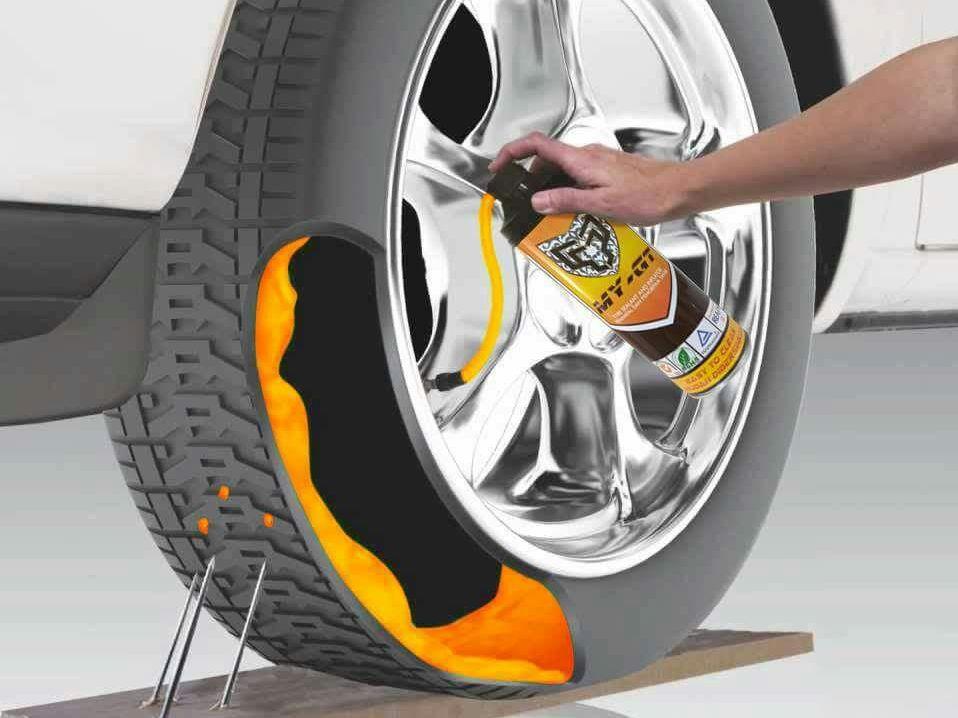 Visit your local Firestone Complete Auto Care and ask about our tire repair services. Your safety is our priority, and we back all of our work with a triple promise that guarantees your repair will be Fixed Right, Priced Right, Right on time.
Visit your local Firestone Complete Auto Care and ask about our tire repair services. Your safety is our priority, and we back all of our work with a triple promise that guarantees your repair will be Fixed Right, Priced Right, Right on time.
Now that you know when to repair vs. replace a car tire, schedule your appointment today!
Brian England, Tue, Feb 21, 2017
Need an automobile tire repaired? Know what’s acceptable when it comes to repairing your tires. Not all tire punctures are created equal; some can be repaired, and some can’t. Car tires that are improperly repaired can fail and result in an accident. For example, this photo shows an example of a repair that should never have been done.
What is an acceptable tire repair? Here are some guidelines.
1. Only repair punctures that fall within the tread area. First of all, you need to take a look at where the puncture area is. Repairs should be limited to the tread area only. If a repair is beyond the tread area (see the photo below) on the side or along the edge like in the above photo, then the tire should be replaced. Do not make or allow a repair. A reputable tire repair shop would not agree to perform an unsafe repair.
First of all, you need to take a look at where the puncture area is. Repairs should be limited to the tread area only. If a repair is beyond the tread area (see the photo below) on the side or along the edge like in the above photo, then the tire should be replaced. Do not make or allow a repair. A reputable tire repair shop would not agree to perform an unsafe repair.
2. Replace tires with punctures greater than 1/4″ in diameter. When it comes to tire punctures, size is important. If the damage resulting from a tire puncture is bigger than 1/4 inch in diameter, it is not safe to complete the repair.
3. Don’t get a tire repaired if the treads are less than 1/16 inch or if it is badly damaged. There’s no sense in repairing a tire that shouldn’t be on the road in the first place. If the treads are less than 1/16 inch, then the tire isn’t safe for road use; it’s time for a replacement. But, there are other times when a replacement is called for.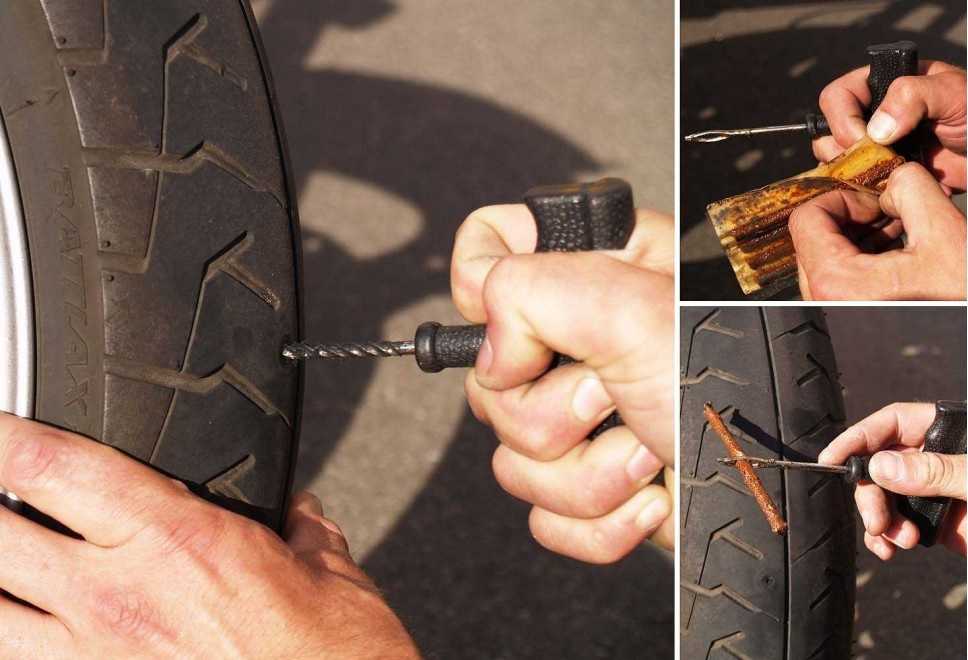 We posted this photo on Facebook recently showing a tire where the tread depth is okay, but the tire is badly damaged. The orange circle shows the small cracks caused by dry rot. The pink circle shows where chunks of the tire tread are missing. If your tire has either one of these problems, replace it versus repairing it.
We posted this photo on Facebook recently showing a tire where the tread depth is okay, but the tire is badly damaged. The orange circle shows the small cracks caused by dry rot. The pink circle shows where chunks of the tire tread are missing. If your tire has either one of these problems, replace it versus repairing it.
4. Make sure that the professional repairing your damaged automobile tire removes the tire from the rim in order to fully inspect the damaged area. The inner liner may have sustained damage that is not visible from the outside.
5. Ensure that your tire is repaired properly with a patch and plug assembly. A plug alone is not an acceptable repair. The photo below shows the type of patch/plug assembly that should be used (on the right) versus one that should not (a plug only on the left).
6. Don’t overlap repairs. If a new puncture is in the same place as an existing repair, then the tire should be replaced.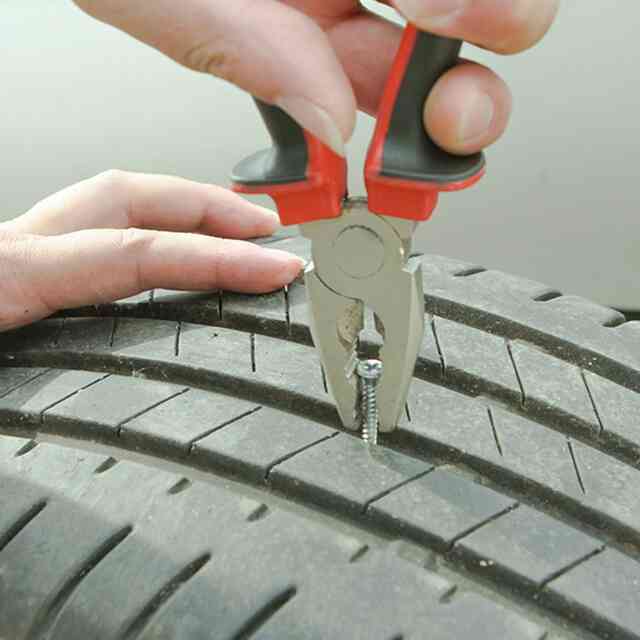 Don’t have it repaired.
Don’t have it repaired.
Depending on the type of tire you have, there may be some other limitations or restrictions on repairs. Be sure to take your damaged tire to a professional for repair or replacement. For more information on safely repairing tires, check out the Rubber Manufacturers Association website at www.betiresmart.org or stop by BA Auto Care. We’ll take a look at your tire, and let you know if you have an unsafe repair.
Note: This article, originally published back in 2012, has been updated.
Author: Kirill Savchenko
“Chief, you've got ten minutes of work to do, the hole is nothing! Well, come up with something . .. ”Every tire fitter has probably heard such words. Alas, not all tire damage can be repaired ...
.. ”Every tire fitter has probably heard such words. Alas, not all tire damage can be repaired ...
But the situation can be reversed. A wheel pierced by protruding reinforcement may be repairable, while a small cut will write off the tire for scrap. Experienced tire fitters believe that it all depends on the point of damage and the object that caused it.
Most often, drivers encounter punctures in the tread area of a tire. It is not always possible to detect it immediately. If in the days of tires and chambers the wheel lost pressure at the slightest puncture, then tubeless tires are much more reliable in this regard. A nail or self-tapping screw usually closes the puncture site, preventing air from escaping quickly.
With such a "plug" you can sometimes drive for months. The tire can lose pressure minimally without arousing suspicion. At the same time, an attempt to pull out a noticed nail on the way is likely to turn into a problem. In this case, the only recommendation is to pull out a foreign object only in a tire shop and repair the wheel.
In most cases, tread punctures are sealed either with special harnesses (some for temporary use, some for permanent use) or patches from the inside of the tire. Even damage caused by massive pins can be repaired. The main thing is that a piece of the tire along with the cord is not torn out.
In the latter case, the hole is filled with raw rubber, vulcanized, and a special cord patch is placed on the inside. But this will only be a temporary measure. In addition, such repairs are not cheap, and purchasing a new tire can be both more profitable and safer.
In addition to the plaster, cord “fungi” are also used. Lubricated with glue, the “fungus” is inserted into the puncture from the inside of the tire, then the excess part of the “leg” is cut off from the outside.
On the other hand, a cord patch can seriously help with side cuts. And car owners meet with them quite often. But here there are several nuances. In a roadside tire shop, the cut will most likely not heal.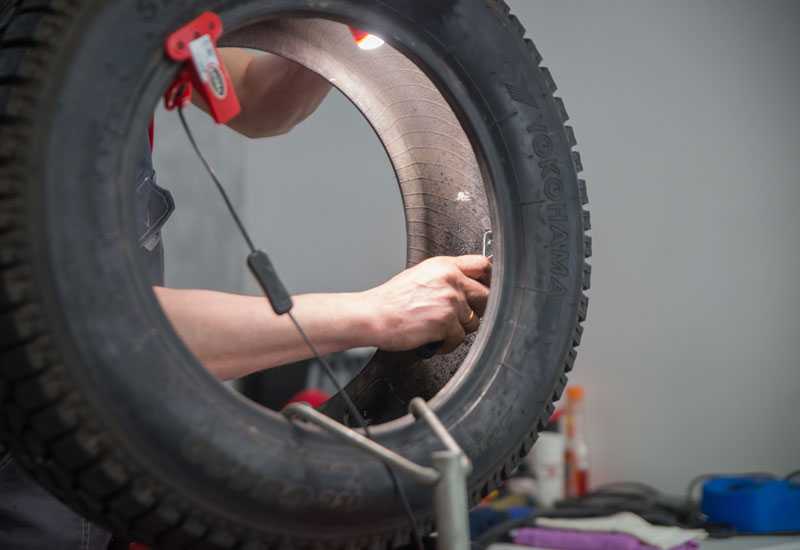 You need to contact a company with specialized equipment, primarily vulcanization.
You need to contact a company with specialized equipment, primarily vulcanization.
And one vulcanizer is not enough here. Cord patches should be with a certain number of layers, designed for strictly defined damage sites and of a suitable size. And again we are talking about the nuances.
If the cut is in the shoulder area of the tire, then it is often impossible to repair it properly. The tire fitter who offered such a service is at great risk, even if he claims that he will weave a piece of new cord with his hands and vulcanize it. There are no miracles in this situation, but in any case, the last word belongs to an experienced specialist.
Low-profile tires with a tread height of less than 50% of the width are difficult to heal side cuts. That is why, in the case of using a car on roads with a possibility of tire damage, it is better to put those that are higher. They are much easier and cheaper to repair.
By the way, what appears to be a cut at first glance may not be one.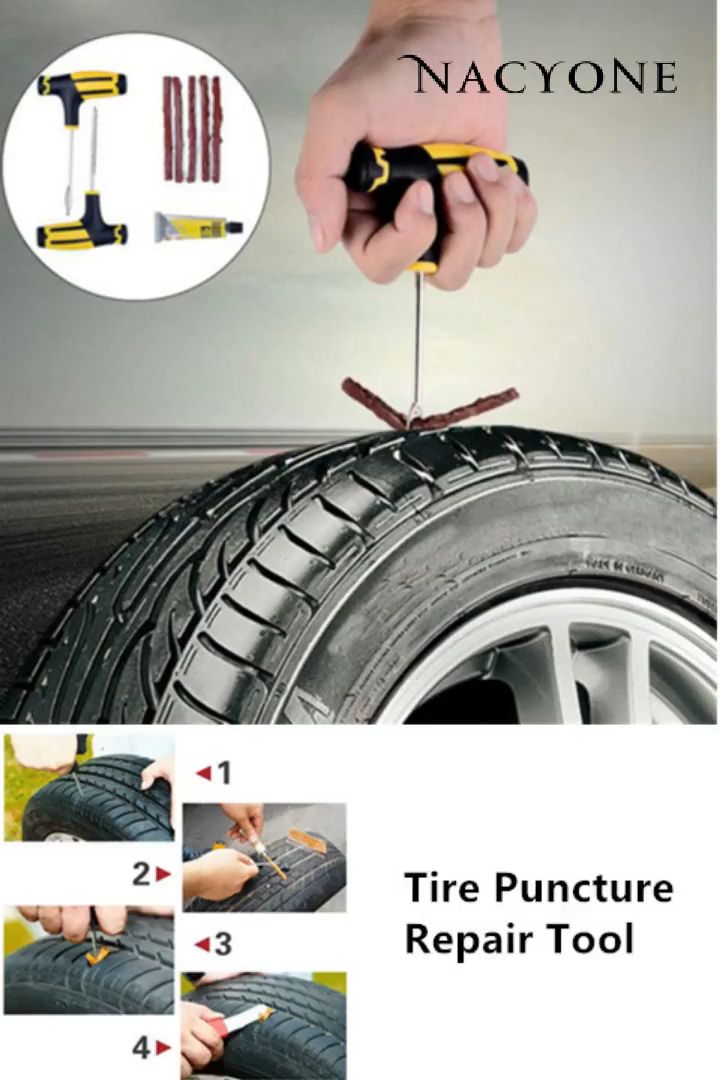 If the sidewall of the wheel catches on something sharp, and a tear forms on the tire without damaging the cord, then this is called a pinch. It does not carry momentary danger and does not require any complex repairs.
If the sidewall of the wheel catches on something sharp, and a tear forms on the tire without damaging the cord, then this is called a pinch. It does not carry momentary danger and does not require any complex repairs.
However, if a piece of rubber remains, then it is glued with ordinary superglue. If not, you will need raw rubber and a vulcanizer. It is impossible to leave the cord bare: under the influence of moisture, it can collapse, which will lead to the complete loss of the tire.
One of the most common and fatal tire defects is swelling or simply "herniation". Despite the absence of open damage to the rubber, such a wheel will be scrapped ahead of schedule. The fact is that when the sidewall is hit, the threads of the tire carcass break. Even if the swelling is very small, sooner or later the bump grows in size, and this is already fraught with an explosion of the wheel at speed.
However, some hernias can be repaired, but this is again a temporary measure. Masters can put cord patches even in the tread area. But only on condition that the distance from the sidewall to the swelling is more than 40 mm. If less, the tire is not subject to further operation. By the way, on low-profile tires, hernias, for the most part, are not repairable - both on the tread and on the sidewalls.
Masters can put cord patches even in the tread area. But only on condition that the distance from the sidewall to the swelling is more than 40 mm. If less, the tire is not subject to further operation. By the way, on low-profile tires, hernias, for the most part, are not repairable - both on the tread and on the sidewalls.
One of the major tire problems is caused by unprofessional repairs. Moreover, the owner most often does not know about it. We are talking about damage to the bead ring, as a result of which the tire does not initially hold the specified pressure.
Eventually the bead ring begins to push out of the rim. At high speed or under heavy load, such a wheel can be disassembled, which again threatens the car with a loss of control.
This damage can be repaired provided that the wire ring or base is not damaged. Special technologies for such repairs are not provided, but experienced craftsmen use the so-called "cold" or chemical vulcanization using a two-component sealant. The resulting mass covers places where there is no rubber on the bead ring. The main condition is to wait three days before mounting the tire on the disc.
As for Run Flat tires, according to the instructions of most manufacturers, they are not subject to repair. In extreme cases, you can use a bottle of special pressurized sealant that comes as a repair kit.
Comment of the expert of the company "SHINSERVICE":
Alexander Golubev
expert "SHINSERVICE"
First of all, we recall that most tire manufacturers do not recognize handicraft tire repair. It is considered a sign of external influence and changes in the design of the tire. Such a tire automatically voids the warranty. This does not happen if tire repairs are carried out in specialized, authorized tire brands services. Note that almost all major tire brands give their own extended warranty, according to which in most cases the repair is free, at a discount, or the product is generally replaced with a similar one, depending on the conditions of the program.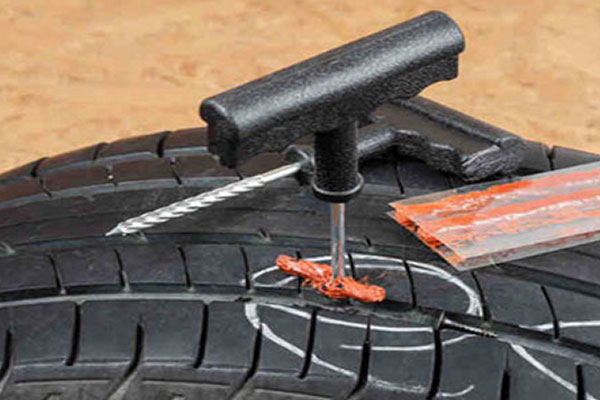
Based on our experience, we can note that in most cases damage in the bead area and in the shoulder area is not repairable.
I would also like to draw attention to the fact that most low-profile tires have high speed indexes (V and above), and even after professional repair they will not be able to be used in the previous modes without restrictions. Therefore, we strongly recommend changing the tire in all cases, except for tread punctures.
practice tires and wheels
Articles / Supercars Scary, very scary: why the US banned drag on the Dodge Demon and other production cars Fast cars are bought in order to drive fast. And to drive as fast as possible, you need to drive in a straight line. These common truths are especially well understood in America - a country that, with ... 143 0 2 05.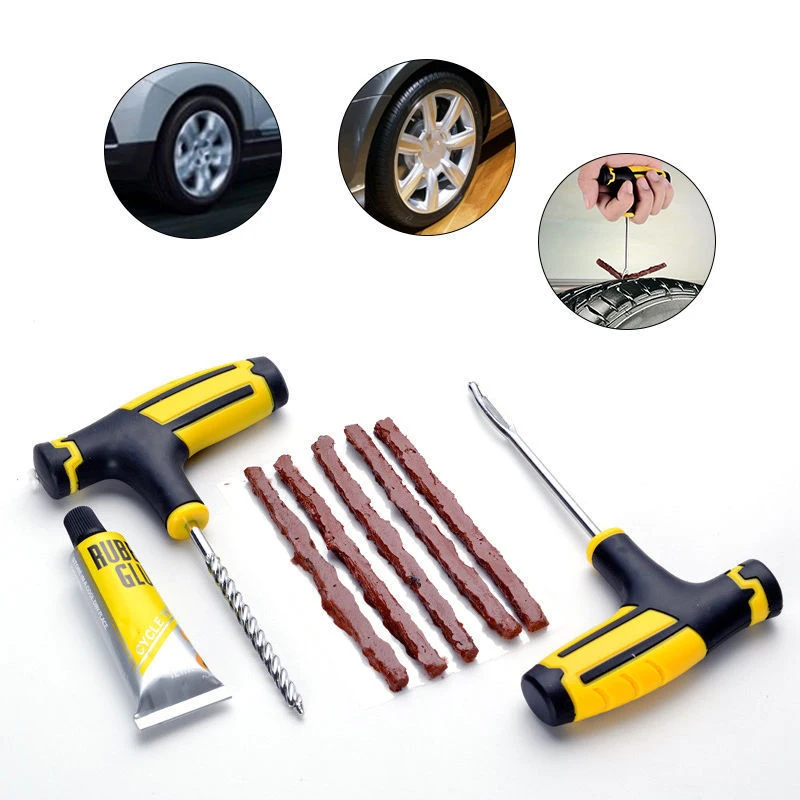 11.2022
11.2022
Articles / Practice Frozen: why the car can not warm up for a long time "Winter! The peasant, triumphant…” warms up the car for half an hour. And sometimes not a peasant, but quite a boyar in an expensive car still warms it up, freezes and thinks: well, why is it so ... 542 0 2 04.11.2022
Articles / Used cars Used Jaguar XJ III X350/358: progressive aluminum body and archaic electrics If you are not an avid fan of the brand, then it is unlikely to distinguish this car from previous XJs. Stylistically, it follows the idea laid down back in the 60s: a low recognizable silhouette, a conservative interior…... 725 one one 03. 11.2022
11.2022
Test drives / Test drive Haval Dargo vs Mitsubishi Outlander: the dog is barking, the stranger is coming In the Haval dealership in the south of Moscow, life is in full swing: buyers look at cars, communicate with managers and sign some papers. While I was waiting for the test Dargo, the same cross... 15224 7 205 13.09.2022
Test drives / Test drive Motor from Mercedes, emblem from Renault, assembly from Dacia: test drive of the European Logan 1.0 It would seem that what's new can be told about the second generation Renault Logan, known to every Russian taxi driver, as they say, up and down? However, this car has.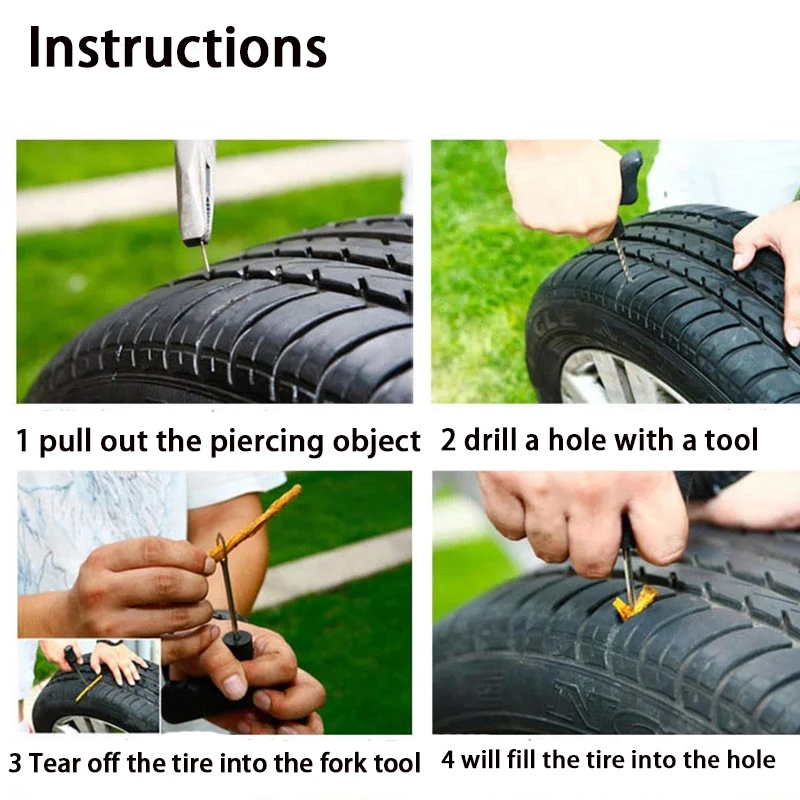 .. 12925 ten 41 08/13/2022
.. 12925 ten 41 08/13/2022
Test drives / Test drive Geely Coolray vs Haval Jolion: Free Cheese? If! Do you want to buy a car today with a full warranty, on credit at an adequate rate, without wild dealer markups? Now this is still a task, because a full-fledged chain of "representation - s... 9977 25 thirty 08/10/2022
Answer your question
We are open around the clock
24 hours a day
We work seven days a week
7 days a week
This happened to most of us. You are driving to your destination with a load, or you are driving home and puncture a tire. Naturally, you stop and think - what to do with the puncture.
You are driving to your destination with a load, or you are driving home and puncture a tire. Naturally, you stop and think - what to do with the puncture. The tire must be dismantled and delivered to a tire repair shop (a truck tire shop on Dmitrovskoye Shosse) to check, rubber does not always need to be replaced. Depending on where the puncture is located, as well as the nature and extent of the damage, the tire may well get by with only a small repair.
A tire can be repaired if it is punctured in the area where a puncture can be repaired: the sidewall and shoulder of the tire must not be repaired and the puncture does not exceed 1 cm in diameter. Repair areas do not overlap or damage is not directly opposite each other.
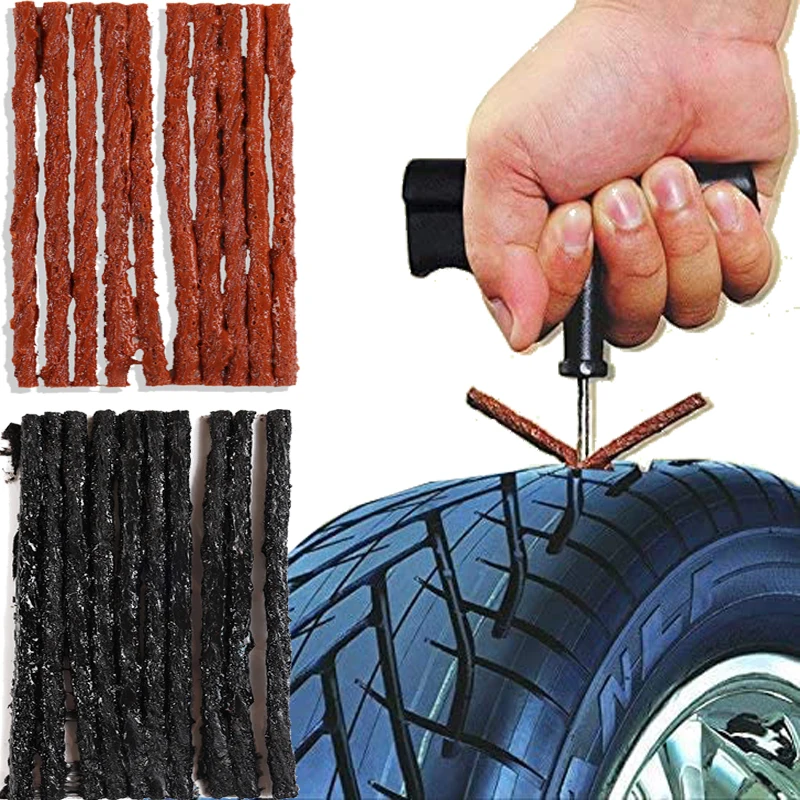 Once it is determined that the tire is repairable, trim the puncture area of the damaged casing to clean and stabilize the area.
Once it is determined that the tire is repairable, trim the puncture area of the damaged casing to clean and stabilize the area. From the inside out, a rubber rod is pulled through the puncture site, covering the inside of the tire. The puncture site is polished from the inside, then a special vulcanizing glue is applied. Then, a patch is applied to the inner pad (over the puncture area), causing a chemical reaction.
Finally, the tire is placed back on the rim, inflated to the correct tire pressure, and the repair checked for leaks. All procedures take 60-90 minutes, in many services cashless payments are available today.
If the tire is damaged in any way outside the “repair area” of the puncture, it cannot be repaired safely. Professional repair of a truck tire (Dolgoprudny city) is limited to the middle or tread area of the tire - this is the area from the center of the tread to the area approximately at a distance of 3 to 5 centimeters from each shoulder (towards the sidewall). For most tires, the puncture repair area can also be identified by the first major groove on both shoulders.
For most tires, the puncture repair area can also be identified by the first major groove on both shoulders.
If there is a noticeable bubble on the sidewall of the tire, it is a bulge, most likely the tire has been damaged by hitting a curb, pothole, or other feature (blemish) on the road surface. The resulting bulge or "bubble" on the sidewall is beyond repair and unfortunately the tire must be retired from service.
Specific repair limits should be based on the tire manufacturer's repair recommendations or policy or the type of tire service (eg CAO tire service).
The only way to properly repair a tire is to remove it from the rim so it can be inspected from the inside, remove the damaged material, fill the voids with rubber, and seal the inner lining with a repair tool.